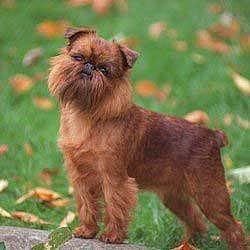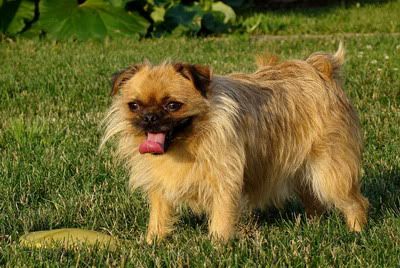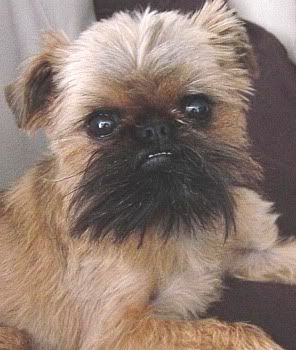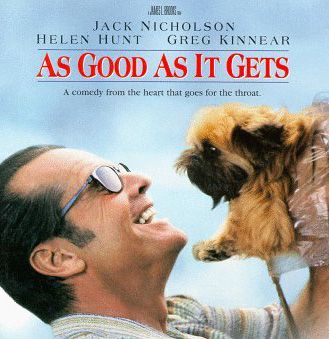Post by charmingnancy on Mar 23, 2009 15:56:34 GMT -5
Griffon (Brussels)
Group: 5- Toys
Origin: Belgium
Purpose: Ratters

Description:
A toy dog, intelligent, alert, sturdy, with a thick-set short body, a smart carriage and set-up, attracting attention by its almost human expression.
Appearance- Breed Standards:
Coat and Colour: There are two distinct types of coat - rough and smooth. The rough coat should be wiry and dense, the harder and more wiry the better. On no account should the dog look or feel woolly, and there should be no silky hair anywhere. The coat should not be so long as to give a shaggy appearance, but should still be distinctly different all over from the smooth coat. The head should be covered with wiry hair, slightly longer around the eyes, nose, cheeks, and chin, thus forming a fringe. The smooth coat is similar to that of the Boston Terrier or English Bulldog, with no trace of wire hair.
In the rough-coated type, coat is either:
(a) reddish brown, with a little black at the whiskers and chin allowable, or
(b) black and reddish brown mixed, usually with black mask and whiskers, or
(c) black with uniform reddish brown markings, usually appearing under the chin, on the legs, over the eyebrows, around the edges of the ears and around the vent, or
(d) solid black.
The colours of the smooth-coated type are the same as those of the rough-coated type. Any white hairs in either the rough or smooth coat are a serious fault, except for "frost" on the black muzzle of a mature dog, which is natural.
Head: Skull large and round, with a domed forehead. Nose very black, extremely short, its tip being set back deeply between the eyes so as to form a lay-back. The nostrils large, the stop deep. Lips edged with black, not pendulous but well brought together, giving a clean finish to the mouth. Chin must be undershot, prominent, and large with an upwards sweep. The incisors of the lower jaw should protrude over the upper incisors and the lower jaw should be rather broad. Neither teeth nor tongue should show when the mouth is closed. Eyes should be set well apart, very large, black, prominent, and well open. The eyelashes long and black. Eyelids edged with black. Ears small and set rather high on the head. May be shown cropped or natural. If natural they are carried semi-erect.
Neck: Medium length, gracefully arched.
Forequarters: Forelegs of medium length, straight in bone, well muscled, set moderately wide apart and straight from the point of the shoulders as viewed from the front. Pasterns short and strong.
Body: Back level and short, brisket should be broad and deep, ribs well sprung.
Hindquarters: Hind legs set true, thighs strong and well muscled, stifles bent, hocks well let down, turning neither in nor out. Feet round, small and compact, turned neither in nor out. Toes well arched. Black pads and toenails preferred.
Tail: Set and held high, docked to about one-third.
Faults: Any white hairs in either the rough or smooth coat are a serious fault. A wry mouth is a serious fault.
Disqualifications: Dudley or butterfly nose, white spot or blaze anywhere on coat, hanging tongue, jaw overshot.
Scale of Points
Head: Skull- 5
Nose and stop- 10
Eyes- 5
Chin and jaws- 10
Ears- 5= 35
Coat: Colour- 12
Texture- 13= 25
Body and General Conformation:
Body (brisket and rib)- 15
Legs- 10
Feet- 5= 30
General appearance: (neck, topline, and tail carriage)- 10= 10
TOTAL= 100
Size:
For the class of dogs and bitches of a small size, the weight should not exceed 7 lb. (3 kg). For the class of dogs and bitches of a large size, that is weighing more than 7 lb. (3 kg), the weight should not exceed 11 lb. (5 kg) for dogs and 12 lb. (5.5 kg) for bitches.
Note: Type and quality are of greater importance than weight, and a smaller dog that is sturdy and well proportioned should not be penalized.

Temperament:
This charming and clever dog makes an excellent companion. The Brussels Griffon is high-strung and lively and will cause a fuss if it believes it is being threatened. The Brussels Griffon loves to bark, and be spoiled. It can also be a picky eater, difficult to housebreak and moody.
Health:
The Brussels Griffon suffers from potential eye problems, slipping patellas, difficult to breed (some require Cesarean section), and respiratory problems.
Average Lifespan:
With proper care most Brussels Griffons will live well into their teens.

History:
The Brussels Griffon takes its name from the capital of Belgium, and it was in Belgium that much of the breed’s development took place. In the early 19th century, it was a common practice for small terriers to be kept in stables to control the vermin population. One such breed was called the Griffons d'Ecurier, or “wire-coated stable dog.” The Brussels Griffon is thought to have originated from a blend of the Griffons d'Ecurier, King Charles Spaniel, Ruby Spaniel and Pug. From this breeding effort emerged two distinct coat types, smooth and wiry.
In the late 1800s, the Brussels Griffon found its way from the stables to the drawing rooms of royalty. Queen Marie Henriette adored the Brussels Griffon and began breeding them. Because of her involvement and interest, two clubs were started in both England and the United States. After both World War I and World War II, the breed was almost completely extinct in its native land. Thankfully, some English breeders were able to revive the Brussels Griffon. In 1910, the Brussels Griffon was recognized by the American Kennel Club.
While this breed has never been wildly popular, it is becoming more so these days. One reason is the renewed interest in small dogs in general. Another is the appearance of a Brussels Griffon in the popular movie As Good as It Gets, starring Jack Nicholson and Helen Hunt.

Sources:
CKC (Breed Standard)
New Year Griffons
Doggies.com
Pictures:
Photobucket
Group: 5- Toys
Origin: Belgium
Purpose: Ratters

Description:
A toy dog, intelligent, alert, sturdy, with a thick-set short body, a smart carriage and set-up, attracting attention by its almost human expression.
Appearance- Breed Standards:
Coat and Colour: There are two distinct types of coat - rough and smooth. The rough coat should be wiry and dense, the harder and more wiry the better. On no account should the dog look or feel woolly, and there should be no silky hair anywhere. The coat should not be so long as to give a shaggy appearance, but should still be distinctly different all over from the smooth coat. The head should be covered with wiry hair, slightly longer around the eyes, nose, cheeks, and chin, thus forming a fringe. The smooth coat is similar to that of the Boston Terrier or English Bulldog, with no trace of wire hair.
In the rough-coated type, coat is either:
(a) reddish brown, with a little black at the whiskers and chin allowable, or
(b) black and reddish brown mixed, usually with black mask and whiskers, or
(c) black with uniform reddish brown markings, usually appearing under the chin, on the legs, over the eyebrows, around the edges of the ears and around the vent, or
(d) solid black.
The colours of the smooth-coated type are the same as those of the rough-coated type. Any white hairs in either the rough or smooth coat are a serious fault, except for "frost" on the black muzzle of a mature dog, which is natural.
Head: Skull large and round, with a domed forehead. Nose very black, extremely short, its tip being set back deeply between the eyes so as to form a lay-back. The nostrils large, the stop deep. Lips edged with black, not pendulous but well brought together, giving a clean finish to the mouth. Chin must be undershot, prominent, and large with an upwards sweep. The incisors of the lower jaw should protrude over the upper incisors and the lower jaw should be rather broad. Neither teeth nor tongue should show when the mouth is closed. Eyes should be set well apart, very large, black, prominent, and well open. The eyelashes long and black. Eyelids edged with black. Ears small and set rather high on the head. May be shown cropped or natural. If natural they are carried semi-erect.
Neck: Medium length, gracefully arched.
Forequarters: Forelegs of medium length, straight in bone, well muscled, set moderately wide apart and straight from the point of the shoulders as viewed from the front. Pasterns short and strong.
Body: Back level and short, brisket should be broad and deep, ribs well sprung.
Hindquarters: Hind legs set true, thighs strong and well muscled, stifles bent, hocks well let down, turning neither in nor out. Feet round, small and compact, turned neither in nor out. Toes well arched. Black pads and toenails preferred.
Tail: Set and held high, docked to about one-third.
Faults: Any white hairs in either the rough or smooth coat are a serious fault. A wry mouth is a serious fault.
Disqualifications: Dudley or butterfly nose, white spot or blaze anywhere on coat, hanging tongue, jaw overshot.
Scale of Points
Head: Skull- 5
Nose and stop- 10
Eyes- 5
Chin and jaws- 10
Ears- 5= 35
Coat: Colour- 12
Texture- 13= 25
Body and General Conformation:
Body (brisket and rib)- 15
Legs- 10
Feet- 5= 30
General appearance: (neck, topline, and tail carriage)- 10= 10
TOTAL= 100
Size:
For the class of dogs and bitches of a small size, the weight should not exceed 7 lb. (3 kg). For the class of dogs and bitches of a large size, that is weighing more than 7 lb. (3 kg), the weight should not exceed 11 lb. (5 kg) for dogs and 12 lb. (5.5 kg) for bitches.
Note: Type and quality are of greater importance than weight, and a smaller dog that is sturdy and well proportioned should not be penalized.

Temperament:
This charming and clever dog makes an excellent companion. The Brussels Griffon is high-strung and lively and will cause a fuss if it believes it is being threatened. The Brussels Griffon loves to bark, and be spoiled. It can also be a picky eater, difficult to housebreak and moody.
Health:
The Brussels Griffon suffers from potential eye problems, slipping patellas, difficult to breed (some require Cesarean section), and respiratory problems.
Average Lifespan:
With proper care most Brussels Griffons will live well into their teens.

History:
The Brussels Griffon takes its name from the capital of Belgium, and it was in Belgium that much of the breed’s development took place. In the early 19th century, it was a common practice for small terriers to be kept in stables to control the vermin population. One such breed was called the Griffons d'Ecurier, or “wire-coated stable dog.” The Brussels Griffon is thought to have originated from a blend of the Griffons d'Ecurier, King Charles Spaniel, Ruby Spaniel and Pug. From this breeding effort emerged two distinct coat types, smooth and wiry.
In the late 1800s, the Brussels Griffon found its way from the stables to the drawing rooms of royalty. Queen Marie Henriette adored the Brussels Griffon and began breeding them. Because of her involvement and interest, two clubs were started in both England and the United States. After both World War I and World War II, the breed was almost completely extinct in its native land. Thankfully, some English breeders were able to revive the Brussels Griffon. In 1910, the Brussels Griffon was recognized by the American Kennel Club.
While this breed has never been wildly popular, it is becoming more so these days. One reason is the renewed interest in small dogs in general. Another is the appearance of a Brussels Griffon in the popular movie As Good as It Gets, starring Jack Nicholson and Helen Hunt.

Sources:
CKC (Breed Standard)
New Year Griffons
Doggies.com
Pictures:
Photobucket

